A Cluster Analysis of Forward Trajectory to Identify the Transport Pathway of Salt-Dust Particles from Dried Bottom of Aral Sea, Central Asia
Abstract
1. Introduction
2. Materials and Methods
2.1. Description of Aral Sea
2.2. Data and Method
3. Results and Discussions
3.1. Classification of Air Parcel from Dried Bottom of Aral Sea
3.2. Occurrence Frequency and Meteorological Characteristics of Each Cluster
- (1)
- Cluster 1: E category.
- (2)
- Cluster 2: NE category.
- (3)
- Cluster 3: W category.
- (4)
- Cluster 4: S category.
3.3. Relationships between Air Mass Clusters and Synoptic Pressure System
4. Conclusions
Author Contributions
Funding
Institutional Review Board Statement
Informed Consent Statement
Data Availability Statement
Acknowledgments
Conflicts of Interest
References
- Orlovsky, N.S.; Orlovsky, L.; Indotiu, R. Severe dust storms in Central Asia. Arid Ecosyst. 2013, 4, 161–201. [Google Scholar] [CrossRef]
- Xin, X.; Irina, N.; Sokolik, R. Quantifying the anthropogenic dust emission from agricultural land use and desiccation of the Aral Sea in Central Asia. J. Geophys. Res. 2016, 20, 145–154. [Google Scholar]
- Huang, X.T.; Hedi, O.; Hans, V.S.; Philippe, S. Dust deposition in the Aral Sea: Implications for changes in atmospheric circulation in central Asia during the past 2000 years. Quat. Sci. Rev. 2011, 30, 3661–3674. [Google Scholar] [CrossRef]
- Glantz, M.; Figueroa, R. Does the Aral Sea merit heritage status? Glob. Environ. Chang. 1997, 7, 357–380. [Google Scholar] [CrossRef]
- Glazovskiy, N.F. The Aral crisis: Causative factors and means of solution (Aral’skiy krizis: Prichiny vozniknoveniya i put’ vykhoda). In Nauka; Springer: Berlin/Heidelberg, Germany, 1990; pp. 20–23. [Google Scholar]
- Middleton, N. The Aral Sea. In The Physical Geography of Northern Eurasia; Shahgedanova, M., Ed.; Oxford University Press: Oxford, UK, 2002; pp. 497–510. [Google Scholar]
- Micklin, P.P. Desiccation of the Aral Sea: A water management disaster in the Soviet Union. Science 1988, 241, 1170–1176. [Google Scholar] [CrossRef] [PubMed]
- Lydolph, P.E. Climates of the Soviet Union; Elsevier: Amsterdam, The Netherlands, 1977. [Google Scholar]
- Ding, Y.H. Buildup, air-mass transformation and propagating of Siberian high and its relations to cold surge in East Asia. Meteorol. Atmos. Phys. 1990, 44, 281–292. [Google Scholar]
- Gong, D.Y.; Ho, C.H. The Siberian High and climate change over middle to high latitude Asia. Theor. Appl. Climatol. 2002, 72, 1–9. [Google Scholar] [CrossRef]
- Fang, X.M.; Shi, Z.T.; Yang, S.L.; Yan, M.D.; Li, J.J.; Jiang, P.A. Loess in the Tian Shan and its implications for the development of the Gurbantunggut Desert and drying of northern Xinjiang. Chin. Sci. Bull. 2002, 4716, 1381–1387. [Google Scholar] [CrossRef]
- Han, W.X.; Fang, X.M.; Ye, C.C.; Teng, X.H.; Zhang, T. Tibet forcing Quaternary stepwise enhancement of westerlies jet and central Asian aridification: Carbonate isotope records from deep drilling in the Qaidam salt playa, NE Tibet. Glob. Planet. Chang. 2014, 116, 68–75. [Google Scholar] [CrossRef]
- Plaisance, H.; Galloo, J.C.; Guillermo, R. Source identification and variation in the chemical composition of precipitation at two rural sites in France. Sci. Total Environ. 1997, 206, 79–93. [Google Scholar] [CrossRef]
- Cretaux, J.F.; Letolle, R.; Kouraev, A. The Aral sea level variability. In The Aral Sea Environment; Springer: Berlin/Heidelberg, Germany, 2010; pp. 181–193. [Google Scholar]
- Stohl, A. Trajectory statistics—A new method to establish source–receptor relationships of air pollutants and its application to the transport of particulate sulfate in Europe. Atmos. Environ. 1996, 30, 579–587. [Google Scholar] [CrossRef]
- Aili, A.; Xu, H.; Kasim, T.; Abulikemu, A. Origin and transport pathway of dust storm and its contribution to particulate air pollution in northeast edge of Taklimakan Desert, China. Atmosphere 2021, 12, 113. [Google Scholar] [CrossRef]
- Katsoulis, B.D. The potential for long-range transport of air pollutants into Greece: A climatological analysis. Sci. Total Environ. 1999, 231, 101–113. [Google Scholar] [CrossRef]
- Hsu, Y.K.; Holsen, T.M.; Hopke, P.K. Comparison of hybrid receptor models to locate PCB sources in Chicago. Atmos. Environ. 2003, 37, 545–562. [Google Scholar] [CrossRef]
- Poissant, L. Potential sources of atmospheric total gaseous mercury in the St. Lawrence river valley. Atmos. Environ. 1999, 33, 2537–2547. [Google Scholar] [CrossRef]
- Karaca, F.; Anil, I.; Alagha, O. Long-range potential source contributions of episodic aerosol events to PM10 profile of a megacity. Atmos. Environ. 2009, 43, 5713–5722. [Google Scholar] [CrossRef]
- He, Z.; Kim, Y.J.; Ogunjobi, K.O.; Hong, C.S. Characteristics of PM2.5 species and long-range transport of air masses at Taean background station, South Korea. Atmos. Environ. 2003, 37, 219–230. [Google Scholar] [CrossRef]
- Jilili, A.; Liu, D.W.; Wu, G.Y. Saline dust storms and their ecological impacts in arid regions. J. Arid Land 2010, 2, 144–150. [Google Scholar]
- Indoitu, R.; Orlovsky, L.; Orlovsky, N. Dust storms in Central Asia: Spatial and temporal variations. J. Arid Environ. 2012, 85, 62–70. [Google Scholar] [CrossRef]
- Karami, S.; Hamzeh, N.H.; Kaskaoutis, D.G.; Rashki, A.; Alam, K.; Ranjbar, A. Numerical simulations of dust storms originated from dried lakes in central and southwest Asia: The case of Aral Sea and Sistan Basin. Aeolian Res. 2021, 50, 100679. [Google Scholar] [CrossRef]
- Draxler, R.R.; Hess, G.D. Description of the HYSPLIT4 Modeling System. NOAA Technical Memorandum, ERLARL-224. 1997. Available online: http://www.arl.noaa.gov/data/web/models/hysplit4/win95/arl-224.pdf (accessed on 24 December 1997).
- Draxler, R.R.; Gillette, D.A.; Kirkpatrick, J.S.; Heller, J. Estimating PM10 air concentrations from dust storms in Iraq, Kuwait and Saudi Arabia. Atmos. Environ. 2001, 35, 4315–4330. [Google Scholar] [CrossRef]
- Man, C.K.; Shih, M.Y. Identification of sources of PM10 aerosols in Hong Kong by wind trajectory analysis. J. Aero Sci. 2001, 32, 1213–1223. [Google Scholar] [CrossRef]
- Jilili, A. Lakes of Arid Land and Salt-Dust Storms; China Environmental Science Press: Beijing, China, 2012. [Google Scholar]
- Sorg, A.; Bolch, T.; Stoffel, M.; Solomina, O.; Beniston, M. Climate change impacts on glaciers and runoff in Tien Shan (Central Asia). Nat. Clim. Chang. 2012, 2, 725–731. [Google Scholar] [CrossRef]
- Dukhovny, V.; Stulina, G. Water and Food Security in Central Asia. NATO Science for Peace and Security, Series C: Environmental Security; Springer: Berlin/Heidelberg, Germany, 2011. [Google Scholar]
- Kim Oanh, N.T.; Chutimon, P.; Ekbordin, W.; Supat, W. Meteorological pattern classification and application for forecasting air pollution episode potential in a mountain-valley area. Atmos. Environ. 2005, 39, 1211–1225. [Google Scholar] [CrossRef]
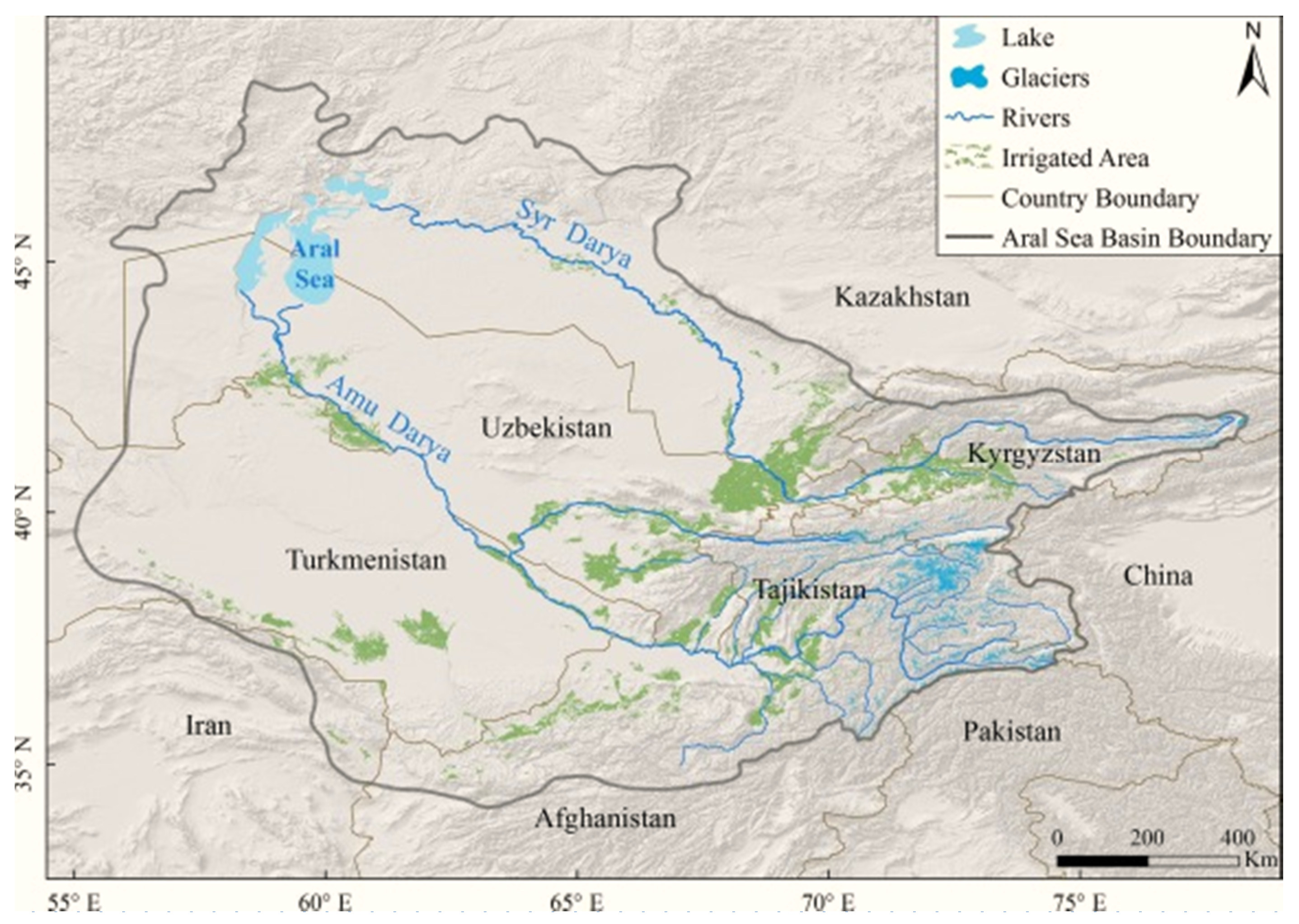
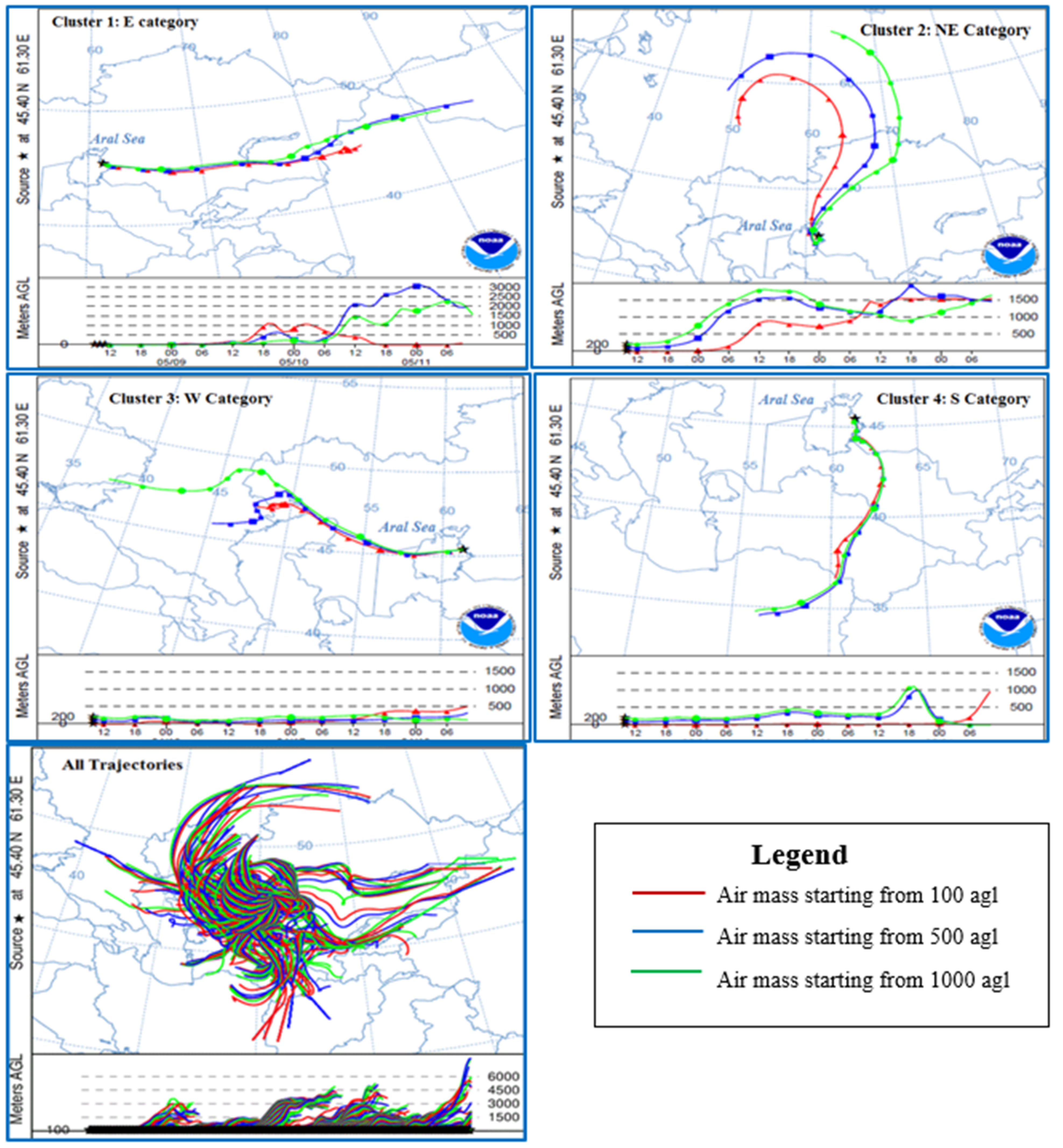
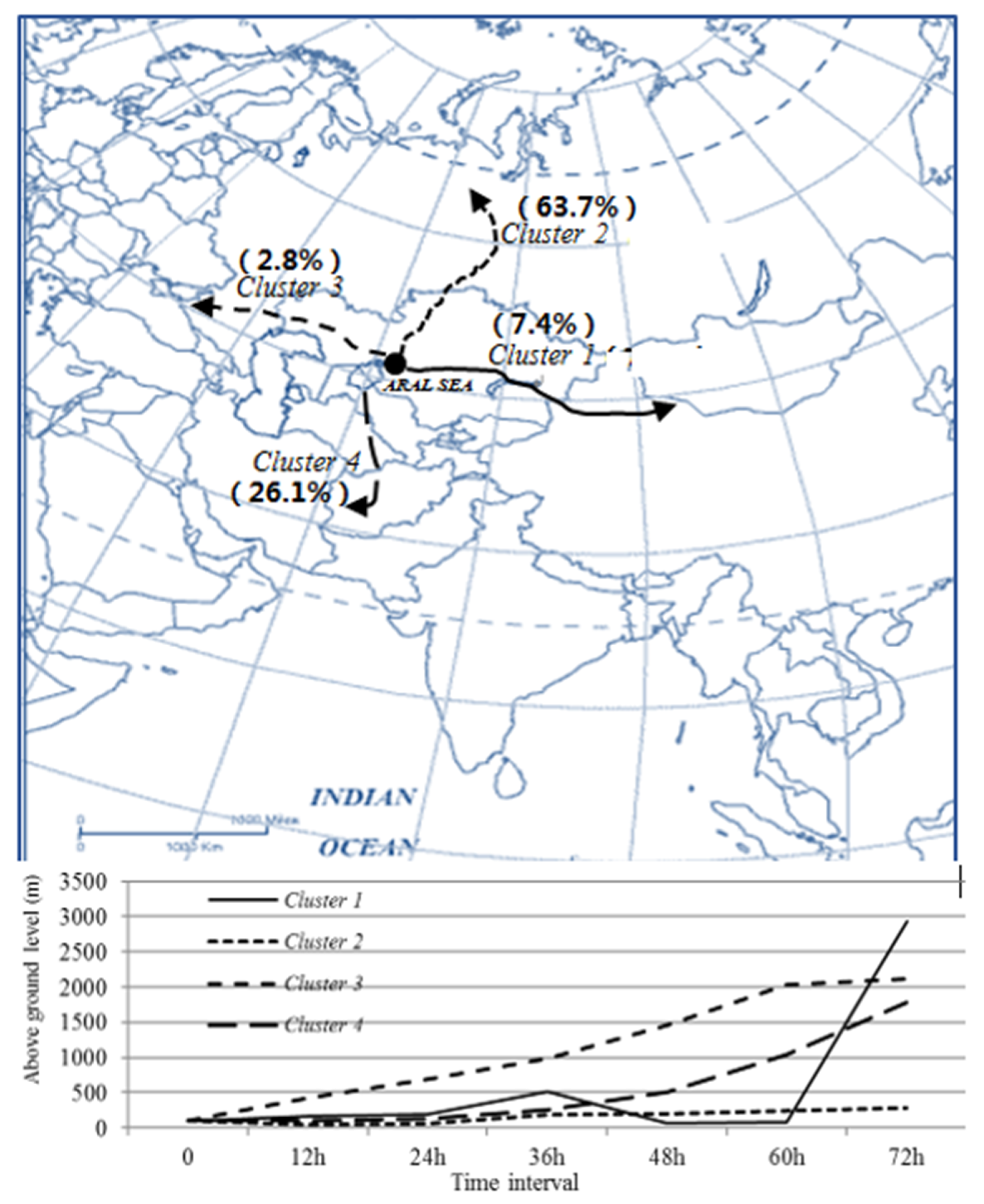
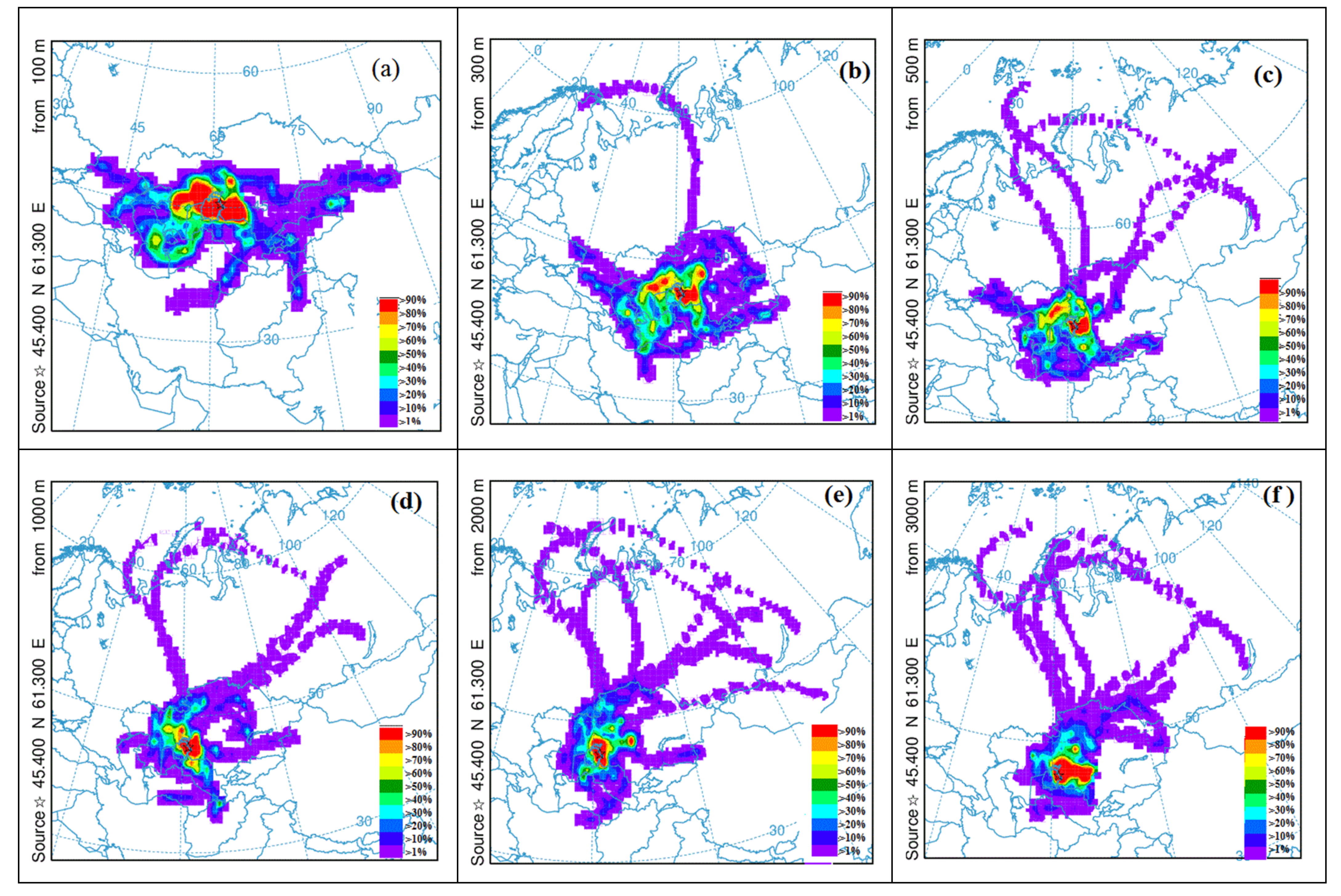
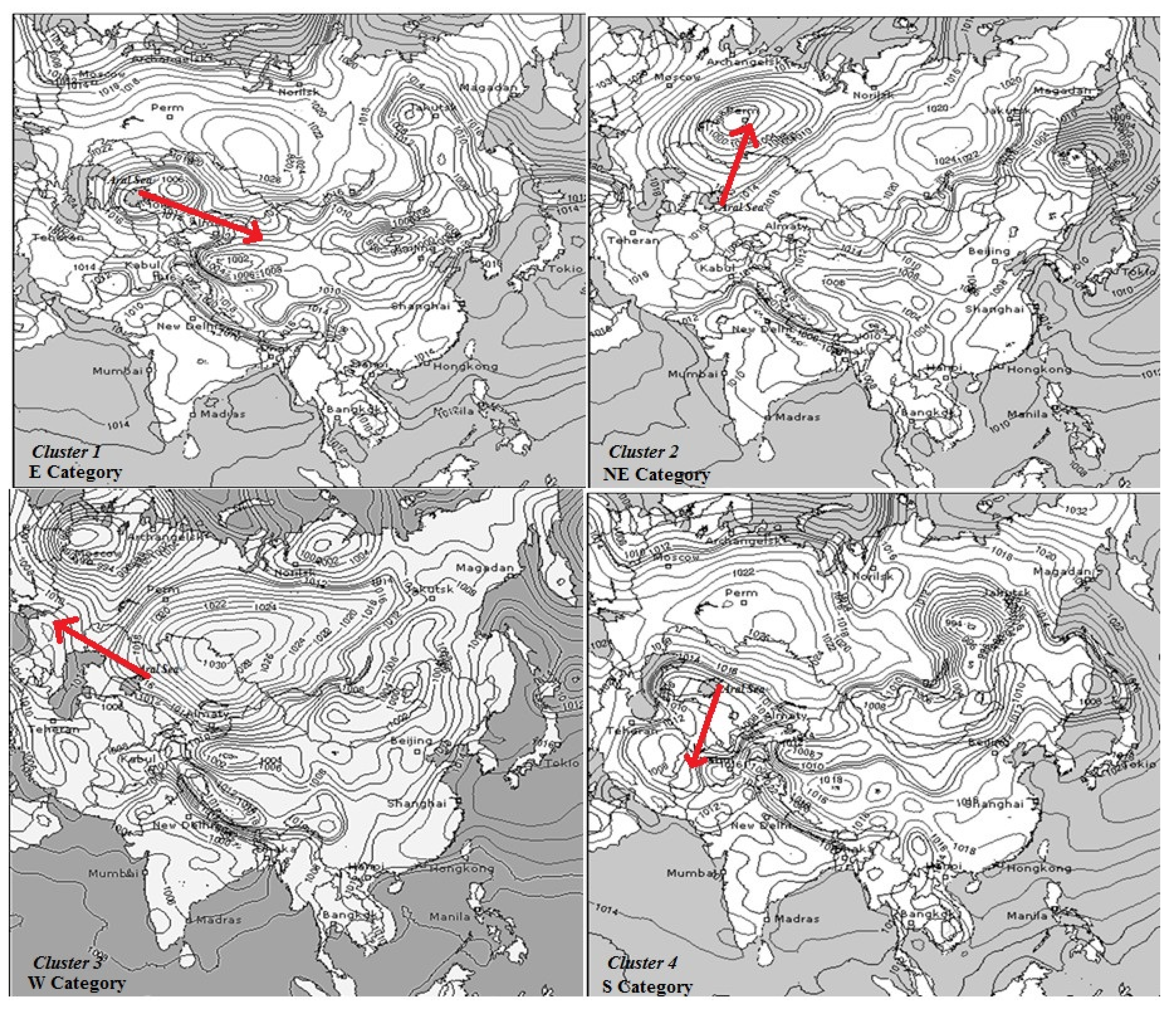
| Variables | Clusters | |||
|---|---|---|---|---|
| E Category | NE Category | W Category | S Category | |
| Number of observed days | 34 | 293 | 13 | 120 |
| March | 7 | 156 | 3 | 19 |
| April | 9 | 102 | 8 | 34 |
| May | 18 | 35 | 2 | 69 |
| Potential temperature (K) | 292.68 | 289.02 | 287.10 | 292.76 |
| Ambient temperature (K) | 293.40 | 290.95 | 287.77 | 293.47 |
| Rainfall (mm/h) | 0.00 | 0.02 | 0.00 | 0.00 |
| Mixing layer depth (m) | 815.19 | 832.08 | 697.47 | 918.16 |
| Relative humidity (%) | 37.88 | 43.60 | 43.17 | 41.47 |
| Solar radiation flux (W/m2) | 796.68 | 733.07 | 768.73 | 734.71 |
Publisher’s Note: MDPI stays neutral with regard to jurisdictional claims in published maps and institutional affiliations. |
© 2021 by the authors. Licensee MDPI, Basel, Switzerland. This article is an open access article distributed under the terms and conditions of the Creative Commons Attribution (CC BY) license (https://creativecommons.org/licenses/by/4.0/).
Share and Cite
Aili, A.; Abuduwaili, J.; Xu, H.; Zhao, X.; Liu, X. A Cluster Analysis of Forward Trajectory to Identify the Transport Pathway of Salt-Dust Particles from Dried Bottom of Aral Sea, Central Asia. Atmosphere 2021, 12, 764. https://doi.org/10.3390/atmos12060764
Aili A, Abuduwaili J, Xu H, Zhao X, Liu X. A Cluster Analysis of Forward Trajectory to Identify the Transport Pathway of Salt-Dust Particles from Dried Bottom of Aral Sea, Central Asia. Atmosphere. 2021; 12(6):764. https://doi.org/10.3390/atmos12060764
Chicago/Turabian StyleAili, Aishajiang, Jilili Abuduwaili, Hailiang Xu, Xinfeng Zhao, and Xinghong Liu. 2021. "A Cluster Analysis of Forward Trajectory to Identify the Transport Pathway of Salt-Dust Particles from Dried Bottom of Aral Sea, Central Asia" Atmosphere 12, no. 6: 764. https://doi.org/10.3390/atmos12060764
APA StyleAili, A., Abuduwaili, J., Xu, H., Zhao, X., & Liu, X. (2021). A Cluster Analysis of Forward Trajectory to Identify the Transport Pathway of Salt-Dust Particles from Dried Bottom of Aral Sea, Central Asia. Atmosphere, 12(6), 764. https://doi.org/10.3390/atmos12060764






